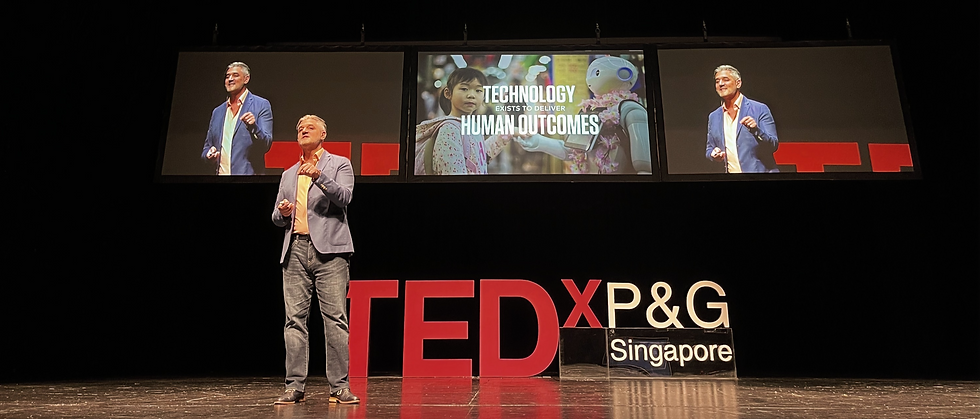TBT Ep59 AI & Advertising - from MAD MEN to MACHINE LEARNING
🚀 AI is transforming advertising, and in this episode, we dive deep into how digital out-of-home (DOOH) advertising is changing the game.
My guest, Dagny Lacka, founder of Flow City, explains how her company is using AI, foot traffic analytics, and real-time bidding to make billboard advertising as dynamic and targeted as online ads. No more two-week static campaigns—now brands can target the right people, at the right time, in the right place.
🎯 What You’ll Learn:
✅ How AI is revolutionising outdoor advertising
✅ The power of real-time ad buying & precision targeting
✅ How challenger brands are using AI to take on big advertisers
✅ The future of DOOH advertising—from 3D billboards to hyperlocal campaigns
🔥 Whether you’re in marketing, AI, or just curious about how technology is reshaping the industry, this episode is packed with insights you don’t want to miss.
🎧 Tune in now!
SHOW NOTES:
⏳ [00:00] Introduction
• Charles welcomes Dagny Lacka, founder of Flow City.
• Today’s topic: How AI is transforming the digital out-of-home (DOOH) advertising industry.
⏳ [01:30] What is Digital Out-of-Home Advertising?
• DOOH is modern outdoor advertising using digital billboards instead of static posters.
• Ads can now be traded in real time, rather than booked in weeks-long slots.
• More flexibility and precision targeting for advertisers.
⏳ [04:15] How Flow City is Changing the Game
• Flow City connects AI, foot traffic data, and ad space to help brands buy smarter and target better.
• Real-time audience insights: Ads are served when the right people are present.
• Example: A tech brand targeting London professionals can buy space at peak commute hours in key locations.
⏳ [08:30] Dagny’s Journey: From Journalism to AI & Advertising
• Started in TV advertising, later shifted into digital outdoor advertising.
• Founded Flow City to make advertising more data-driven and accessible.
• Early challenges: Moving from retail analytics to smart city-driven ad placements.
⏳ [12:00] AI & Footfall Analytics in Advertising
• Predicting audience movement in cities using AI.
• Why traditional retail analytics didn’t work, but DOOH was a perfect match.
• Dynamic content: Tailoring ads in real-time based on location and audience type.
⏳ [16:30] The Pandemic Pivot: Turning Crisis into Growth
• COVID-19 shut down outdoor advertising, leaving Flow City in crisis.
• The tech team used the downtime to develop better automation.
• Breakthrough moment: Secured direct access to premium ad networks, unlocking major growth.
• New model: Clients only pay for ads when they are actually seen, reducing risk.
⏳ [21:00] AI’s Role in Pricing & Campaign Optimization
• AI helps brands find the best locations at the best prices.
• Avoiding high-cost ad slots by identifying when advertising competition is lower.
• Strategic ad buying: Instead of running for two weeks, brands can spread ads over months for better impact.
⏳ [25:15] Challenger Brands vs. Big Advertisers
• Big brands are slow to adopt change, while small brands use AI to disrupt the market.
• Case study: A challenger brand outperformed an industry leader, which eventually went into administration.
• Startups and new brands can now compete with industry giants using targeted, affordable ad placements.
⏳ [30:00] How Flow City Works for Clients
• AI analyzes audience behavior and suggests optimal ad placements.
• Example: Instead of random billboards across London, the system targets a specific group repeatedly for higher impact.
• Smart pricing: Ads are placed where they cost less but still reach the right people.
⏳ [34:00] The Future of Digital Out-of-Home Advertising
• 3D digital ads & transparent screens are the next big innovations.
• Hyperlocal targeting: Global brands are now customizing ads per city and even per neighborhood.
• AI is improving real-time engagement in advertising, making campaigns more interactive.
⏳ [37:30] Startup Challenges & The London VC Scene
• London’s VC market is risk-averse, making it harder for startups to secure funding.
• Many European startups end up raising money in the US or Asia.
• Flow City grew by focusing on profitability instead of chasing VC funding.
⏳ [40:00] Final Thoughts & Closing
• Flow City’s mission: Help challenger brands take market share from incumbents.
• The future: Expanding to more markets, helping millions of businesses run smarter ad campaigns.



















